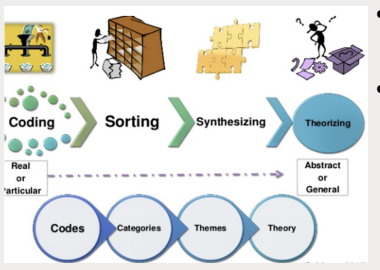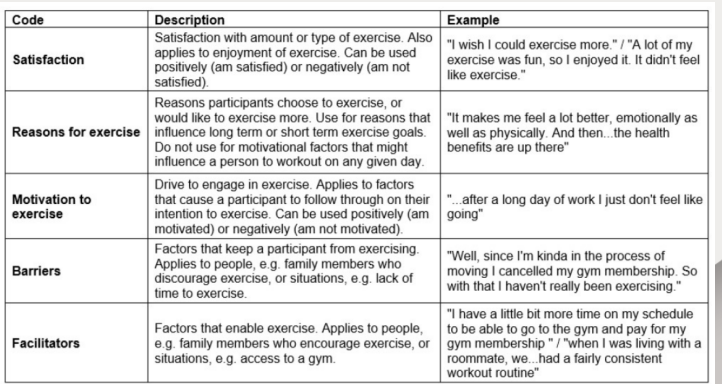QQM: topic 4: qualitative data analysis
1/40
There's no tags or description
Looks like no tags are added yet.
Name | Mastery | Learn | Test | Matching | Spaced |
|---|
No study sessions yet.
41 Terms
distinct features qualitative data analysis
focused on texts
hermeneutic perspective
emic focus
iterative process of progressive focusing
emic focus
representing a setting with the participant’s terms
etic focus
representing a setting with the researcher’s terms (quantitative research)
goals qualitative research
meaning: how people see the world
context: the world in which people act
process: what actions and activities people do
reasoning: why people act and behave the way they do
good qualitative results rely on
quality of data collector
quality of data analyzer
quality of presenter/writer
examples of qualitative data
written field notes
audio recordings of conversations
video recordings of activities
diary recordings of activities/thoughts
qualitative data provides depth info on
thoughts, views, interpretations
priorities, importance
processes, practices
intended effects of actions
feelings and experiences
three steps of reading text
literally: focus on literal content and form
reflexively: researcher orientation shapes interpretation and focus
interpretively: researcher tries to construct own interpretation of text meaning
characteristics qualitative data analysis vs quantitative
focus on meanings
few rather than many cases
in depth rather than general categories
researcher as instrument
sensitivity to context
attention to impact of values on analysis
goal of rich descriptions
steps of qualitative data analysis
documentation of data and data collection
conceptualization and coding
examining relationships
authenticating conclusions
reflexivity
documentation
analysis begins with jottings, field notes, transcripts and so on
essential for keeping track
provides way of developing an outline for analytic process
encourages ongoing conceptualizing
conceptualization, coding and categorizing
may begin with simple observation
analysic insights tested against new observations and modified
facilitated by matrix or chart
coding
process of naming or labelling the data, categories and properties
codes
words, phrases, meaning units, repeated in the data
divide text into a word or phrase/label
categories
sort codes into categroies based on how different codes are related
themes
identify a central category and relate it to other categories
coding process
code => categories => themes

concept driven coding
deductive coding
codes are developed before the coding process begins then look for those ideas in the text/transcripts
codes could be based on interview guide or on theory or existing literature
data-driven coding
inductive coding
no pre-developed system of codes
let the words “speak for themselves” and then construct coding structure based on your review
starting from scratch
codebook
dictionary or guidebook of all codes in project
provides
guidelines for consistent coding across coders
name of the code
definition/description of the code
example of text excerpt that represents the code

examining relationships and displaying data
centerpiece of analytic process
move from description to explanation
can also be diagrammed in chart or matrix
simple relationships can be extended into more complex causal model

authenticating conclusions
how credible was informant?
were statements made by someone who knows the researcher or someone they just met?
did informant have reason to lie?
were statements made in response to researcher’s questions or were they spontaneous?
how does the presence of the researcher or the researcher’s informant influence the actions and statements of other group members?
reflexivity
confidence in conclusions strengthened by account of how researcher interacted with subjects
sensitivity to influences on interpretations of social situation or process
trustworthiness
credibility: confidence in truth of the findings
are they reasonable
do they reflect participants views/experience
transferability: findings have applicability in other contexts
other people, time periods,…
confirmability
neutrality of researcher
researcher’s reality vs participants’ realities
focus on participants’ realities
findings grounded in data
dependability: findings are consistent
study procedures documented and distinguishable
consistency in interview and analysis processes
threats to trustworthiness
reactivity: potentially distorting effects of researchers’ presence on participants’ beliefs and behaviors
social desirability bias/response bias: tendency to survey respondents to answer questions in way that will be viewed favorably by others
researcher’s biases:
choose informants who fit within their world view
asking questions to get desired answers
ignoring data that does not support conclusions
respondent’s biases
withholding info or lying
offer answers they think researchers want to hear
ineffective recall
enhancing trusworthiness
development of coding system
triangulation
sample size
negative case analysis
peer debriefing
thick description
member checking
persistent observation
external audits
researcher’s reflecivity
prolonged engagement
audit trail
peer review
alternatives in qualitative data analysis
grounded theory
narrative analysis
conversation analysis
visual sociology
grounded theory
- systematic theory developed inductively based on observations that are summarised into conceptual categories reevaluated in the research setting and gradually refined and linked to other conceptual categories
steps of grounded theory
summarise observations into conceptual categories
test categories directly in research setting
refine theory again
attempt to discover negative evidence
narrative analysis
focusses on how respondents impose order on the flow of experience in their lives and so make sense of events and actions in which they have participated
coding for narrative analysis
typically of narratives as a whole then of different elements
revolves around reading stories and classifying them into general patterns
conversation analysis
method for analysing ordinary conversation
three premises
interactions sequentially organised and talk can be analysed by process of social interaction
talk is contextually oriented
no interactive details are irrelevant to understand social interactions
one limitation: can easily be misinterpreted
the tone/impression of the statement changes depending if the participant is speaking in a sad, angry or joking manner, notes and memos are very important
visual sociology
social world is “observed” and interpreted through photographs, films and other images
a method for
learning how others “see” the social world
creating images of that world for further study
video recording increasingly popular
video ethnography
why are mixed methods helpful?
reinforce each other
create greater depth of understanding
reveal or correct errors in other methods
fill in the steps in complex social processes
help offset weakness of each technique
help understand complex issues
most popular programs for computer-assisted qualitative data analysis
hyperRESEARCH
QSR Nvivo
Atlas.ti
validity threats
bias: researchers influence on study
reactivity: researchers effect on setting or people
internal generalizability
do findings extend within the group studies?
external generalizability
do findings extend outside the group studied?
face generalizability
there is no reason to believe the results don’t generalize
ethical issues qualitative data analysis
research integrity and quality
ownership of data and conclusions
use and misuse of results
denzin’s interpretative criteria for qualitative analyses
does it illuminate the phenomenon as lived experience?
is it based on contextualized materials?
is it historically and relationally grounded?
is the research processual and interactional?
does it engulf what is known about the phenomenon?